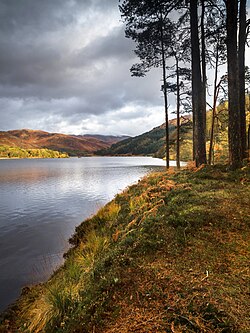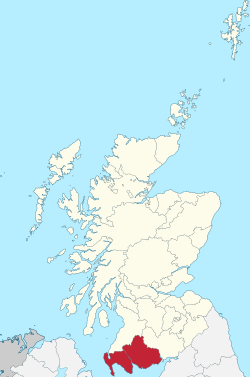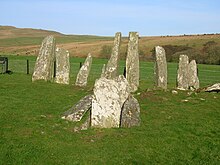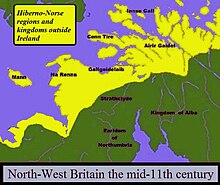Galloway
Galloway | |
|---|---|
 | |
 Galloway (red) shown in Scotland (pink) shown in the United Kingdom (light grey) | |
| Demonym | Gallovidian |
Galloway (Scottish Gaelic: Gall-Ghàidhealaibh [ˈkal̪ˠaɣəl̪ˠu]; Scots: Gallowa; Latin: Gallovidia)[1] is a region in southwestern Scotland comprising the historic counties of Wigtownshire and Kirkcudbrightshire. It is administered as part of the council area of Dumfries and Galloway.
A native or inhabitant of Galloway is called a Gallovidian.[2][3] The region takes its name from the Gall-Gàidheil, or "stranger Gaels", a people of mixed Gaelic and Norse descent who seem to have settled here in the 10th century.[4]
Galloway is bounded by sea to the west and south, the Galloway Hills to the north, and the River Nith to the east; the border between Kirkcudbrightshire and Wigtownshire is marked by the River Cree. The definition has, however, fluctuated greatly in size over history.
A hardy breed of black, hornless cattle named Galloway cattle is native to the region, in addition to the more distinctive Belted Galloway or "Beltie".
Geography and landforms
[edit]

Galloway comprises the part of Scotland lying southwards from the Southern Upland watershed and westward from the River Nith. Traditionally it has been described as stretching from "the braes of Glenapp to the Nith".[5] The valleys of three rivers, the Urr Water, the Water of Ken and River Dee, and the Cree, all running north–south, provide much of the good arable land, although there is also some arable land on the coast. Generally however the landscape is rugged and much of the soil is shallow. The generally south slope and southern coast make for mild and wet climate, and there is a great deal of good pasture.
The northern part of Galloway is exceedingly rugged and forms the largest remaining wilderness in Britain south of the Highlands. This area is known as the Galloway Hills.
Land use
[edit]Historically Galloway has been known both for horses and for cattle rearing, and milk and beef production are both still major industries. There is also substantial timber production and some fisheries. The combination of hills and high rainfall make Galloway ideal for hydroelectric power production, and the Galloway Hydro Power scheme was begun in 1929. Since then, electricity generation has been a significant industry. More recently wind turbines have been installed at a number of locations on the watershed, and a large offshore wind-power plant is planned, increasing Galloway's 'green energy' production.
History
[edit]Galloway landmarks on Ptolemy's map
[edit]

The 2nd century geographer Ptolemy produced a map of Britain in his Geography, in which he describes the landmarks and peoples of the island. The landmarks were identified long ago, and a number of them relate to Galloway:[6]
In the west, the city of Rerigonium (literally 'very royal place'), shown on Ptolemy's map of the world, is a strong contender for the site of Pen Rhionydd, referred to in the Welsh Triads as one of the 'three thrones of Britain' associated with the legendary King Arthur, and may also have been the caput of the sub-Roman Brythonic kingdom of Rheged. Rerigonium's exact position is uncertain except that it was 'on Loch Ryan', close to modern day Stranraer; it is possible that it is the modern settlement of Dunragit (Dun Rheged).
Early Galloway
[edit]

The earliest recorded inhabitants were Brythonic Celts, recorded by the Romans as the Novantae tribe. According to tradition, before the end of Roman rule in Britain, St. Ninian established a church or monastery at Whithorn, Wigtownshire, which remained an important place of pilgrimage until the Reformation. The county is rich in prehistoric monuments and relics, amongst the most notable of which are the Drumtroddan standing stones (and cup-and-ring carvings), the Torhousekie Stone Circle, both in Wigtownshire and Cairnholy (a Neolithic chambered cairn). There is also evidence of one of the earliest pit-fall traps in Europe which was discovered near Glenluce, Wigtownshire.
Middle Ages
[edit]
A Brythonic speaking kingdom dominated Galloway until the late 7th century when it was absorbed by the English kingdom of Bernicia.
English prevalence was supplanted by Britons and Norse-Gaelic (Gall-Ghàidheal) peoples between the 9th and the 11th century. This can be seen in the context of both the vacuum left by Northumbria being filled by the resurgent Cumbric Britons and the influx of the Norse into the Irish Sea, including settlement in the Isle of Man and in the now English region of western Cumbria immediately south of Galloway.
If it had not been for Fergus of Galloway who established himself in Galloway, the region would rapidly have been absorbed by Scotland. This did not happen because Fergus, his sons, grandsons and great-grandson Alan, Lord of Galloway, shifted their allegiance between Scottish and English kings. During a period of Scottish allegiance, a Galloway contingent followed David, King of Scots, in his invasion of England and led the attack in his defeat at the Battle of the Standard (1138).
Alan died in 1234. He had three daughters and an illegitimate son Thomas. The "Community of Galloway" wanted Thomas as their "king". Alexander III of Scotland supported the daughters (or rather their husbands) and invaded Galloway. The Community of Galloway was defeated, and Galloway divided up between Alan's daughters, thus bringing Galloway's independent existence to an end.
Alan's eldest daughter, Derbhorgail (Latinized as Dervorguilla), married John de Balliol, and their son (also John) became one of the candidates for the Scottish Crown. Consequently, Scotland's Wars of Independence were disproportionately fought in Galloway.
There were a large number of new Gaelic placenames being coined post 1320 (e.g. Balmaclellan), because Galloway retained a substantial Gaelic speaking population for several centuries more. Following the Wars of Independence, Galloway became the fief of Archibald the Grim, Earl of Douglas. In 1369, he received the part of Galloway east of the River Cree, where he appointed a steward to administer the area, which became known as the Stewartry of Kirkcudbright. The following year, he acquired the part of Galloway west of the Cree, which continued to be administered by the king's sheriff, and so became known as the Shire of Wigtown.[7] The two parts of Galloway thereafter were administered separately, becoming separate counties.
Whithorn remained an important cultural centre, and all the medieval kings of Scots made pilgrimages there.
Reformation and Covenanters
[edit]Folklore holds that a copy of the Wycliffe Bible was circulating in Galloway around 1520, and secret groups (proto-conventicles) gathered to hear a man named Alexander Gordon preach from it.[8]: 32 With the end of the monasteries, the large ecclesiastical landholdings created under the medieval Lordship of Galloway were broken up amongst hundreds of small landowners. In the case of Dundrennan Abbey, much of the abbey's lands came into the hands of the family of its last abbot, Edward Maxwell.[8]: 33 Following the death of the pre-Reformation Bishop of Galloway in 1575, there were disputes over who would be bishop, and the seat was vacant for a considerable period of time in the late 16th century due to opposition to episcopacy in Scotland.
The Anglo-Scottish Union of the Crowns took place in 1603, leading to the supremacy of the Stuart dynasty in Britain and Ireland. James, the Stuart monarch of both Scotland and England, heavily policed the activities of the riding clans of the nearby Scottish Borders, leading to a large number of Borderers emigrating or being transported to Ireland or to the American colonies. The Plantation of Ulster began around this time.
Attempts by the Stuarts to impose royal absolutism, as well as theological disputes over episcopacy, ultimately triggered the 17th-century Bishops' Wars in Scotland, which saw the appearance of the Covenanters as a social, political, and military force. The Covenanters began as participants in conventicles, which were unsanctioned secret religious gatherings that often took place outdoors, or in barns or granaries. The Covenanter movement was particularly popular in the southwest of Scotland. Covenanters had skirmishes with government troops in Galloway, some of which featured the "Galloway flail", a variant of the agriculturally-derived melee weapon.[9]
Cattle trade
[edit]Galloway's agricultural economy was indirectly affected by the 17th-century Plantation of Ulster. Peasants in Galloway had, dating back to the Middle Ages, traditionally practiced a mixture of dairy-focused pastoral transhumance and intensive agriculture, with pockets of arable land being intensively cultivated by some peasants, while others migrated between upland and lowland pastures with their herds.[8]: 8 Landowners such as Sir John Murray, the earl of Annandale, received large land grants in Ulster which were only suitable for pasture. In order for their tenants in Ireland to pay rent, an export market had to be created, which was soon sanctioned by the Scottish Privy Council, for Irish cattle to be exported to England via Galloway. Some landowners used the cattle trade in the 17th century as a way to grow their landholdings, as the system of a large number of small landholders began to consolidate into larger estates.[8]: 20 The Irish cattle trade increased until up to 10,000 head of cattle per year were being exported through this route in the year 1667. It was in this year that the importation of Irish cattle to England was banned. However, the importation of Scottish cattle was not banned; this created a new opportunity for Galloway landowners to profit from illicit Irish cattle.[8]: 28–29 By this time, a number of prominent individuals associated with the Stuart monarchy held lands in both Galloway and in Ulster, facilitating the illicit trade, which "may have been tolerated for political reasons".[8]: 28 Many of these landowners were also Episcopalians.[8]: 29
Galwegian Gaelic seems to have lasted longer than Gaelic in other parts of Lowland Scotland, and Margaret McMurray (d. 1760) of Carrick (outside modern Galloway) appears to have been the last recorded speaker.
Modern history
[edit]In modern times, Stranraer was a major ferry port, but the company have now moved to Cairnryan.
Galloway in literature
[edit]Galloway has been the setting of a number of novels, including Walter Scott's Guy Mannering. Other novels include the historical fiction trilogy by Liz Curtis Higgs, Thorn in My Heart, Fair is the Rose, and Whence Came a Prince. Richard Hannay flees London to lie low in Galloway in John Buchan's novel The Thirty-nine Steps. Five Red Herrings, a whodunit by Dorothy L. Sayers, initially published in the US as Suspicious Characters, sees Lord Peter Wimsey, on holiday in Kirkcudbright, investigating the death of an artist living at Gatehouse of Fleet; the book contains some remarkable descriptions of the countryside. S R Crockett, a bestselling writer of historical romances active before the First World War, set several novels in the region including The Raiders and Silver Sand.
Galloway is also the setting of several memoirs, including Devorgilla Days written by Wigtownshire author Kathleen Hart, an account of life in Wigtown, Scotland's national book town.
See also
[edit]References
[edit]- ^ Andy Eagle (27 February 2003). "The Online Scots Dictionary". Scots-online.org. Archived from the original on 8 July 2010. Retrieved 18 June 2014.
- ^ "Gallovidian". Dictionary.com. n.d. Retrieved 27 September 2016.
{{cite web}}: CS1 maint: year (link) - ^ "Gallovidian, adj. and n." OED Online. n.d. Retrieved 18 September 2016.
{{cite web}}: CS1 maint: year (link) - ^ Jennings, Andrew (1993). An Historical Study of the Gael and Norse in Western Scotland from c. 795 to c. 1000 (PhD thesis). The University of Edinburgh. pp. 138–146.
- ^ "Those green hills that are the haunt of angels". The Herald. 13 May 1995.
- ^ Ptolemy 140 Ptolemy, Bk. II, Ch. 2. Trans.[who?] Albion island of Britannia - First Map of Europe
- ^ Learmonth, William (1920). Kirkcudbrightshire and Wigtownshire. Cambridge: Cambridge University Press. p. 1. Retrieved 27 November 2022.
- ^ a b c d e f g Livingston, Alistair (2009). The Galloway Levellers: a study of the origins, events and consequences of their actions (PDF) (Thesis). University of Glasgow (Dumfries Campus). Retrieved 10 October 2024.
- ^ Simpson, Robert (1846). Traditions of the Covenanters, or Gleanings Among the Mountains. Presbyterian Board of Publication. p. 38. Retrieved 11 October 2024.
- Brooke, D: Wild Men and Holy Places. Edinburgh: Canongate Press, 1994 ISBN 0-86241-479-2
- Oram, Richard, The Lordship of Galloway. University of St Andrews, 1988
- Ptolemy (c. 140), Thayer, Bill (ed.), Geographia, LacusCurtius website at the University of Chicago, retrieved 26 April 2008
External links
[edit]- Galloway Dialect at Scots Language Centre
